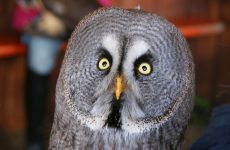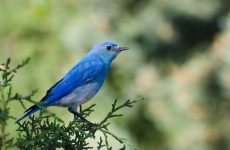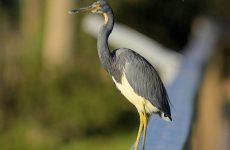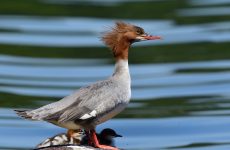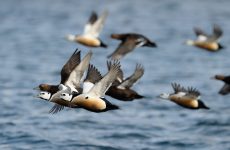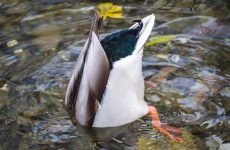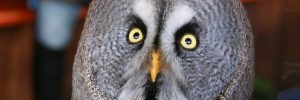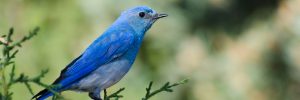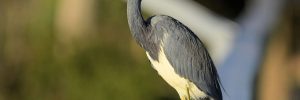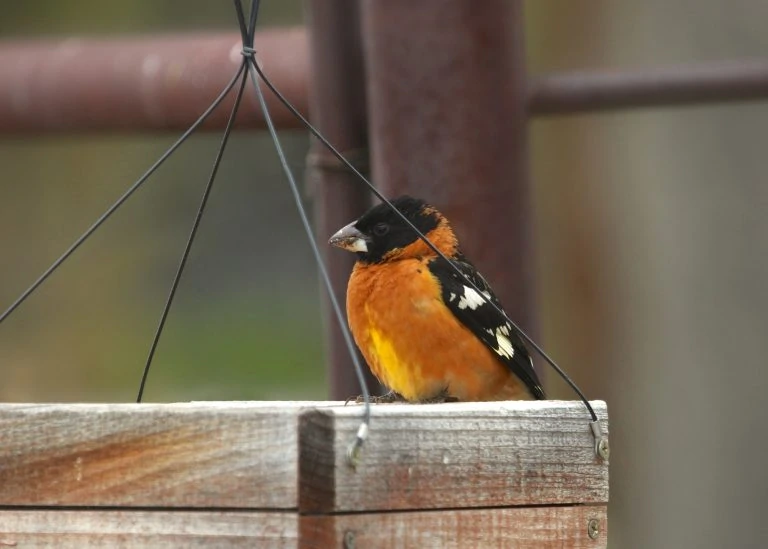
This guide will help you identify black and orange birds in North America, where to find them, and how to attract them to your yard.
Black and orange birds are often orioles or tanagers, but there are many species so how can you tell them apart?
There are also common black and orange birds that you may not know yet.
Red-winged Blackbird
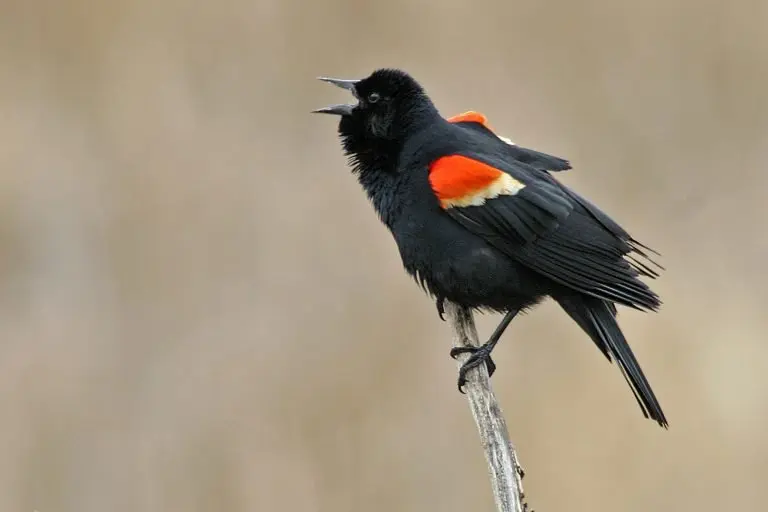
Red-winged blackbirds are very common and easy to identify with the all-black coloring except for the reddish-orange wing patches. Females are rather dull in comparison with brown streaky coloring.
- Length: 6.7-9.1 in (17-23 cm)
- Weight: 1.1-2.7 oz (32-77 g)
- Wingspan: 12.2-15.8 in (31-40 cm)
They can often be spotted sitting on telephone wires and the males will fiercely defend their territories in the breeding season even attacking people that get too close to nests. In winter they roost in large numbers into the millions.
To attract more Red-winged blackbirds to your backyard try mixed grain and seeds spread on the ground. They will also feed on large tube feeders or platform feeders.
Baltimore Oriole
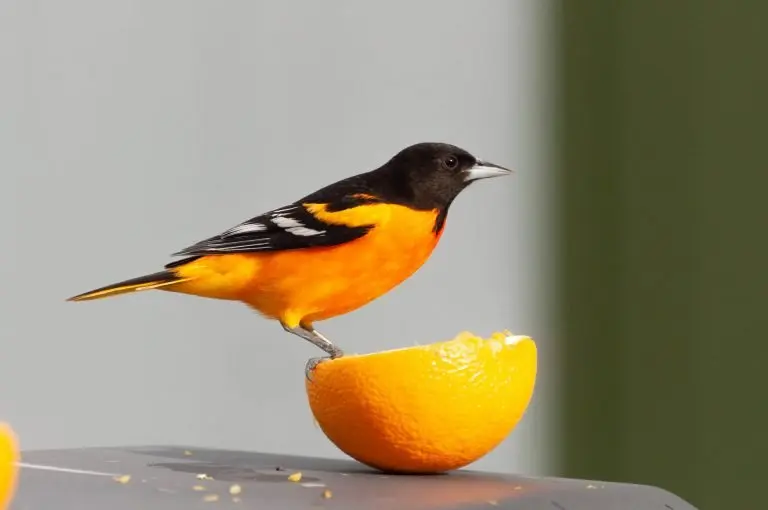
Baltimore Orioles are a colorful sign of spring in the east of North America. The adult males are bright orange and black with white wing bars on the black wings. The male birds have orange chests and bellies, black heads and backs.
Female Baltimore orioles are yellowish underneath and on the head and grayish-brown on the wings, their backs or brownish-yellow. They are about the size of a Robin but more slender and are members of the blackbird family.
- Length: 6.7-7.5 in (17-19 cm)
- Weight: 1.1-1.4 oz (30-40 g)
- Wingspan: 9.1-11.8 in (23-30 cm)
Breeding in Eastern and Central States, including central-southern Canadian provinces and along the southern border with the US, from April.
Baltimore Orioles, then migrate to Florida, Central America, and the Caribbean for winter, leaving as early as July.
They make incredible hanging bag-like nests woven from fibers.
Baltimore Orioles can be found high up in open woodland, riverbanks, and forest edges foraging for insects and fruit and they often come to parks and backyards.
Their diet is insects such as beetles, crickets, and grasshoppers as well as spiders and snails and they help eat pest species. They eat a wide variety of fruits and can damage crops such as raspberries, mulberries, cherries, bananas, and oranges.
To attract more Baltimore Orioles to your yard try oranges cut in half on a platform feeder or hanging from trees. Also, oriole feeders filled with sugar water. Plant fruit and nectar plants such as raspberries, crab apples, and trumpet vines.
Bullock’s Oriole
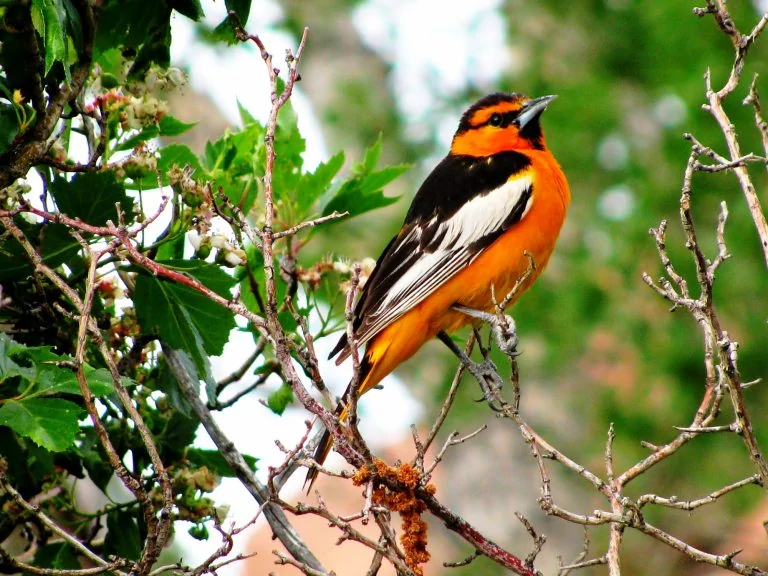
Bullock’s Orioles males are bright orange with black and white wings and black markings on their heads.
Females and immature are duller in comparison with gray backs and yellow heads, tails and chests.
- Length: 6.7-7.5 in (17-19 cm)
- Weight: 1.0-1.5 oz (29-43 g)
- Wingspan: 12.2 in (31 cm)
Bullock’s Orioles breed in the western half of the US and spend the winter in Mexico. Their nests are woven from hair, grass and wool into a gourd shape and take up to 15 days to complete.
They can be found in open woodlands and parks and will visit backyards for fruit and grape jelly and nectar feeders.
Hooded Oriole
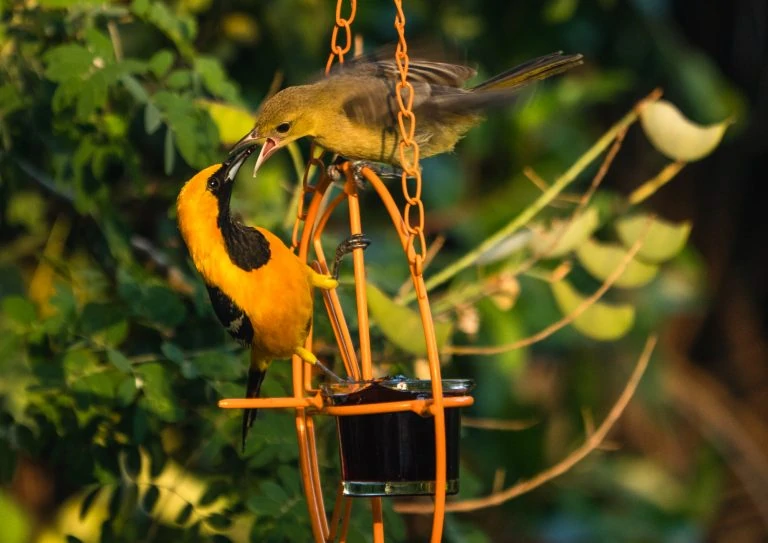
Male Hooded Orioles range from bright yellow to bright orange, with black throats and backs. Females and immatures are more yellow with grayish wings. Females lack the black face markings.
- Length: 7.1-7.9 in (18-20 cm)
- Weight: 0.8 oz (24 g)
- Wingspan: 9.1-11.0 in (23-28 cm)
Hooded Oriole males in Texas tend to be orange in color but those further west are yellow.
They breed in the southern US states, making hanging nests on the undersides of palm fronds. They winter in Mexico and some remain all year on the Gulf Coast of Mexico and Central America.
Some Hooded Orioles have stopped migrating from southern US states because of the ready supply of food from nectar feeders.
They live in dry open areas, especially near palm trees. Their nests are high at around 20 feet off the ground and are a hanging basket weaved from grass and plant material.
They will come to nectar feeders or use fruit to attract orioles.
Orchard Oriole
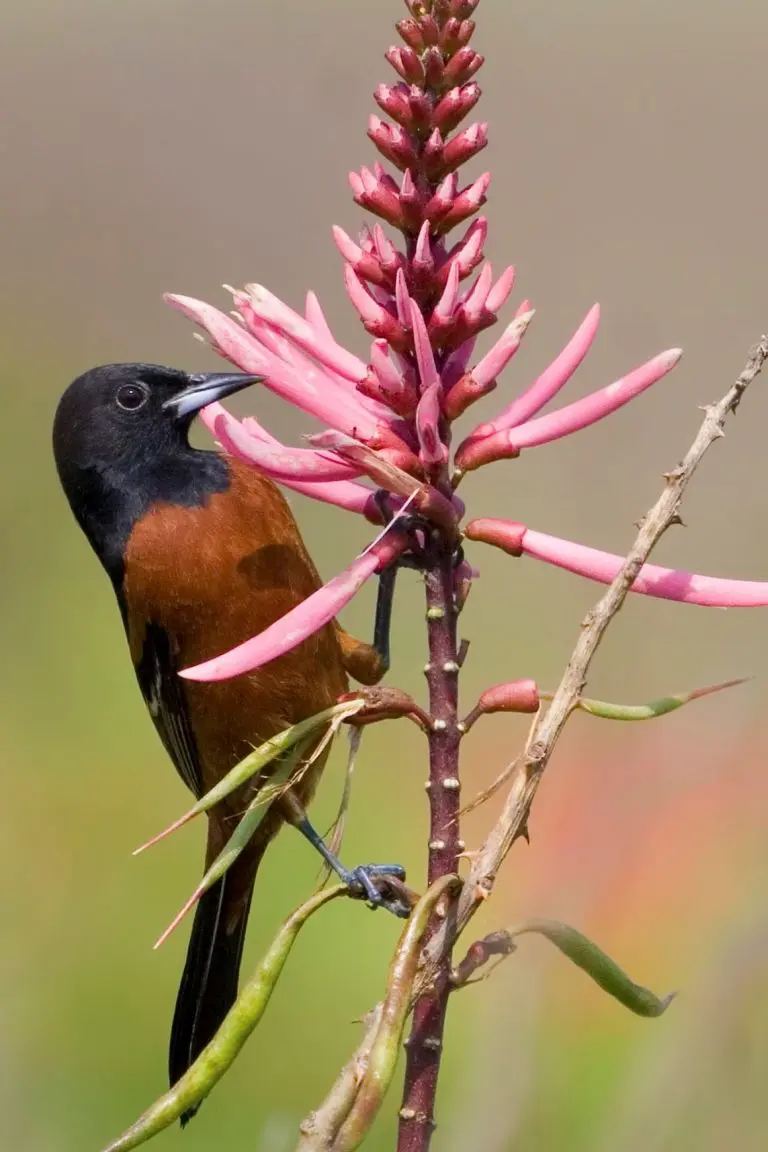
Orchard Orioles males have black heads and backs and reddish-orange bellies. Females are greenish-yellow overall, paler underneath and darker on the back, with darker wings and white wingbars.
- Length: 5.9-7.1 in (15-18 cm)
- Weight: 0.6-1.0 oz (16-28 g)
- Wingspan: 9.8 in (25 cm)
Orchard Orioles breed in central and eastern states in summer, before migrating south to Mexico and Central America.
Preferring open woodland, Orchard Orioles can also be found along river banks and open shrubland and farms as well as backyards. They build hanging pouch-like nests.
Their diet is mostly insects such as ants, caterpillars, beetles, and grasshoppers, as well as spiders. they will also drink nectar from flowers and eat fruit such as mulberries and chokeberries.
To attract Orchard Orioles to your yard try nectar feeders or platform feeders with cut oranges or mango. Also, plant native berry plants such as mulberries or chokeberries.
Altamira Oriole
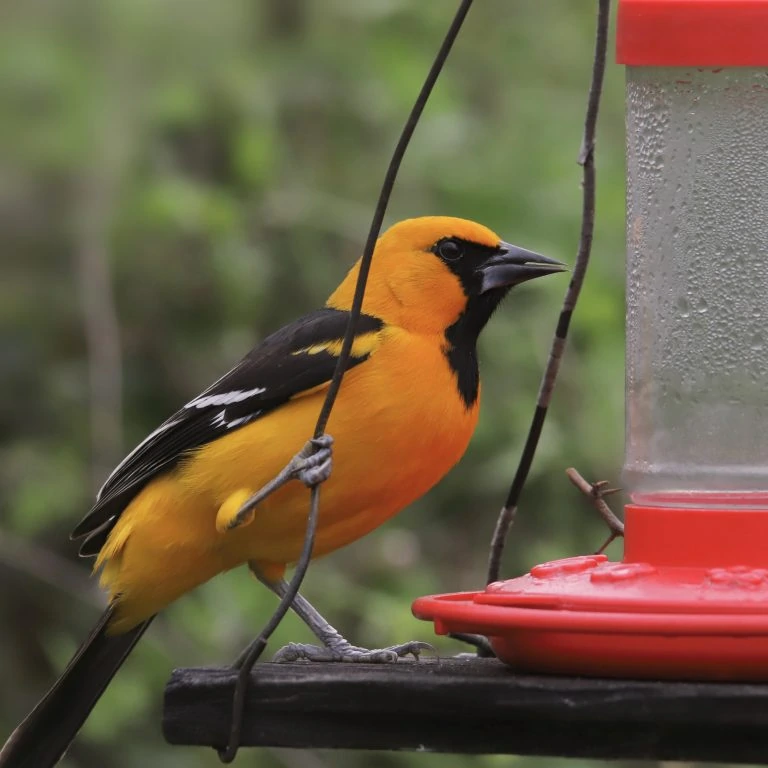
Altamira Orioles are bright yellowish-orange with black backs, wings and tails. These birds with orange heads also have black around the eyes and down the throat. Juveniles are more yellow and have olive backs rather than black.
- Length: 8.3-9.8 in (21-25 cm)
- Weight: 1.7-2.3 oz (47-64 g)
- Wingspan: 14.2 in (36 cm)
Altamira Orioles are rare in the US except in the Rio Grande Valley, Texas and they remain year-round.
Look for them in backyards at sunflower or nectar feeders or in wildlife refuges in southeastern Texas and along the Gulf Coast of Central America. They prefer open woodlands.
Altamira Orioles stay in pairs year-round. Try to look for their amazing hanging nests that measure up to 2 feet long.
Spot-breasted Oriole
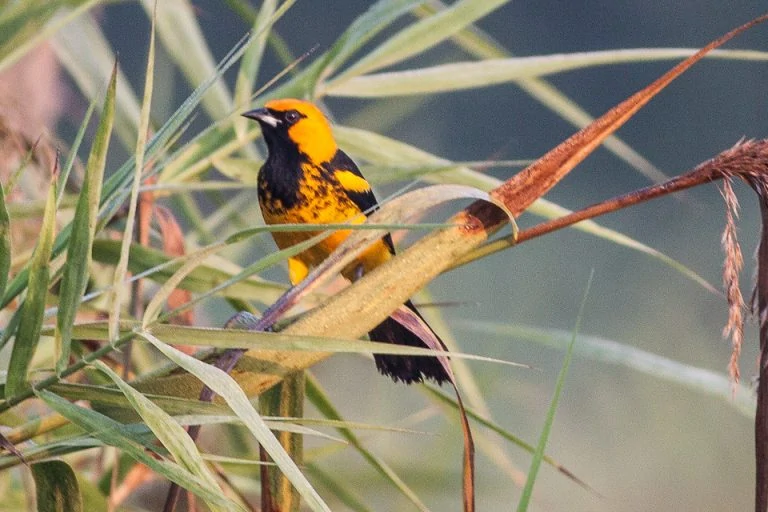
These black and orange birds are Spot-breasted Orioles with black spotting on their orange breast and white on the wing edges. They have black around the face and chest and are black on the back, wings and tail. Juveniles are more yellow in color with dark backs, wings and tails.
- Length: 8.3-9.4 in (21-24 cm)
- Weight: 1.8 oz (50 g)
Spot-breasted Orioles can be found in Florida and along the Gulf Coast but they are not very common in the US. They mostly live in Mexico and Central America along the Pacific Coast.
They live in open woodlands and will visit backyards for fruit and nectar.
Streak-backed Oriole
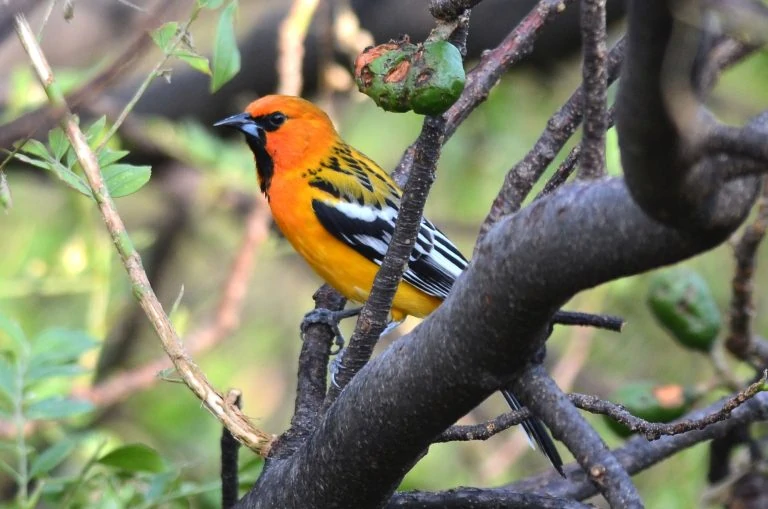
Streak-backed Orioles are orange and black birds with orange heads and undersides and black-streaked wings and a black tail. They have black around the eyes and chin.
They are rare in the US but can be seen in the southwest. Mexico and Central America is their main habitat.
They are found in tropical woodland, grassland and backyards.
American Redstart
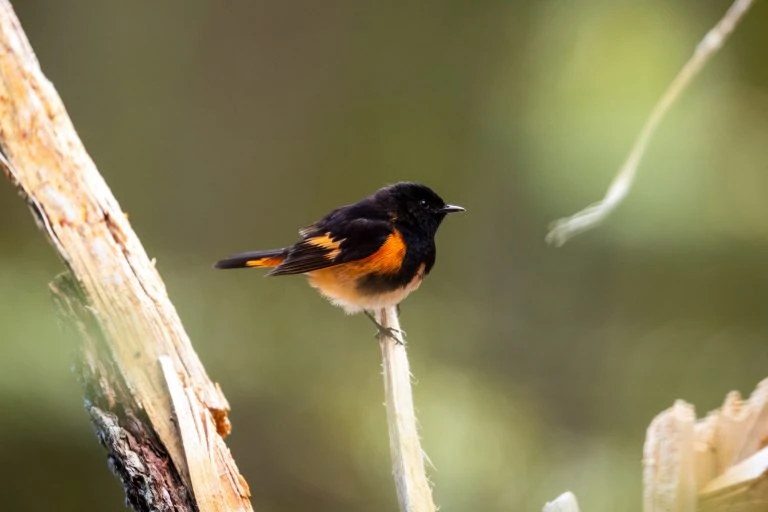
American Redstarts are black and bright birds with a white lower belly. Females are olive-gray instead of black and have yellow patches.
- Length: 4.3-5.1 in (11-13 cm)
- Weight: 0.2-0.3 oz (6-9 g)
- Wingspan: 6.3-7.5 in (16-19 cm)
They have a vast breeding range across eastern US states and Canada and across to northwestern US states and Canada. They may also be seen during migration in central states.
They can be found in deciduous woodlands eating insects and also in backyards and thickets eating berries such as serviceberry and magnolia.
American Robin
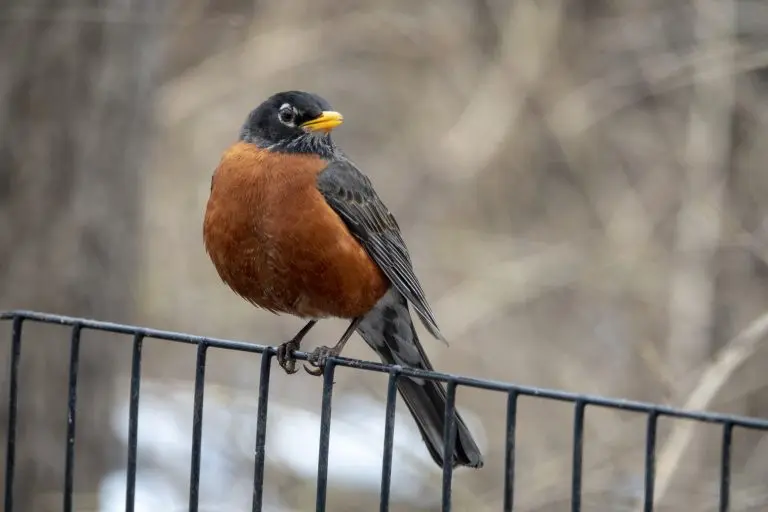
One of the most common black and orange birds; the American Robins is a common sight on lawns eating earthworms. They have black heads and back with red or orange breasts. They tend to roost in trees in winter so you are more likely to see them in your backyard from spring.
- Length: 7.9-11.0 in (20-28 cm)
- Weight: 2.7-3.0 oz (77-85 g)
- Wingspan: 12.2-15.8 in (31-40 cm)
American Robins are common backyard birds in all US states and Canada. Those that breed in Canada migrate further south in winter but those in the US remain all year.
American Robins can be found in many habitats, from woodlands, forests, and mountains to fields, parks, and lawns. They eat earthworms, insects, snails, and fruit.
You can attract more American Robins to your yard with sunflower seeds, suet and peanut hearts, fruit, and mealworms. Platform feeders are best or food scattered on the ground. Also try planting some native plants that produce berries such as juniper, sumac, hawthorn, and dogwood.
Eastern Towhee
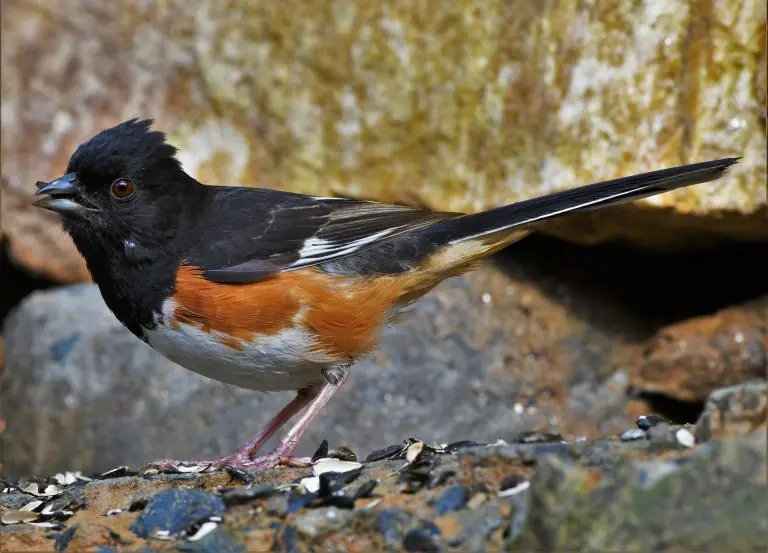
Eastern Towhees are striking large sparrows, about the size of Robin, with a black head, throat, and back, reddish-orange sides, long tails, and a white belly in the males. The females are similar but with brown instead of black.
- Length: 6.8-8.2 in (17.3-20.8 cm)
- Weight: 1.1-1.8 oz (32-52 g)
- Wingspan: 7.9-11.0 in (20-28 cm)
Eastern Towhees live all year in the southeastern states but birds further north move south for the winter and they may only appear in winter on the western edge of their range.
Eastern Towhees spend their time rummaging in the undergrowth and can be found along the edges of forests and thickets.
Eastern Towhees visit feeders for fallen seed if your yard has overgrown borders and will also visit platform feeders for black oil sunflower seeds, hulled sunflower seeds, cracked corn and millet.
Spotted Towhee
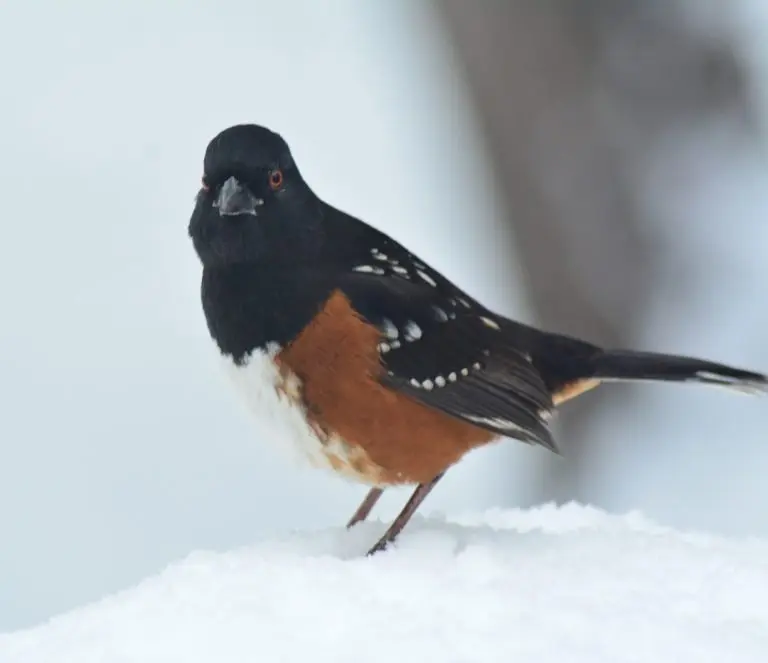
Spotted Towhees are large sparrows that are black on the head, throat, and back in the males and brown in the females. Both males and females have orange-brown sides and white bellies and white spots on the wings and back. They have long tails and are about the size of a Robin.
Spotted Towhees can be found on the ground in dense tangles of shrubs scratching around for insects including beetles, crickets, grasshoppers, caterpillars, wasps, and bees. They also eat acorns, berries, and seeds.
Spotted Towhees stay all year on the Pacific coast. Those from northern central states migrate further south after breeding.
You can attract more Spotted Towhees to your yard if you leave overgrown borders and they will visit platform feeders or ground feeders for Black Oil Sunflower seeds, Hulled Sunflower seeds, Cracked Corn, Millet, and Milo.
Blackburnian Warbler
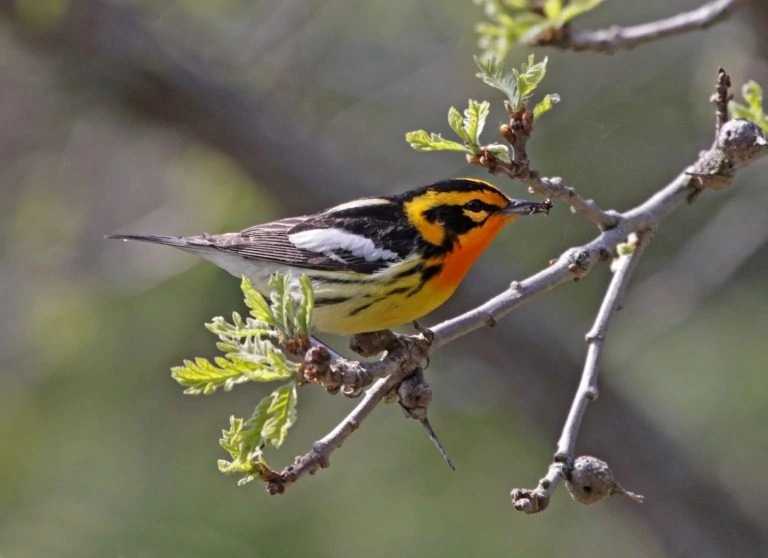
Blackburnian Warbler males are black and orange birds with orange throats and face marking, black backs and wings and white with black streaks on the belly. Females are yellower. They have distinctive dark triangles on each side of their face, by their eyes.
- Length: 4.3-4.7 in (11-12 cm)
- Weight: 0.3-0.4 oz (8.9-12.6 g)
- Wingspan: 7.9-9.1 in (20-23 cm)
Blackburnian Warblers like many warblers can be seen during migration in eastern US states. They breed in Canada and northeastern US states and some may breed as far south as Virginia or North Carolina. They spend winters in South America.
They can be found in woods and forests hunting for caterpillars, but they are difficult to spot as they are often up at the top of trees hidden from view by leaves.
Brambling
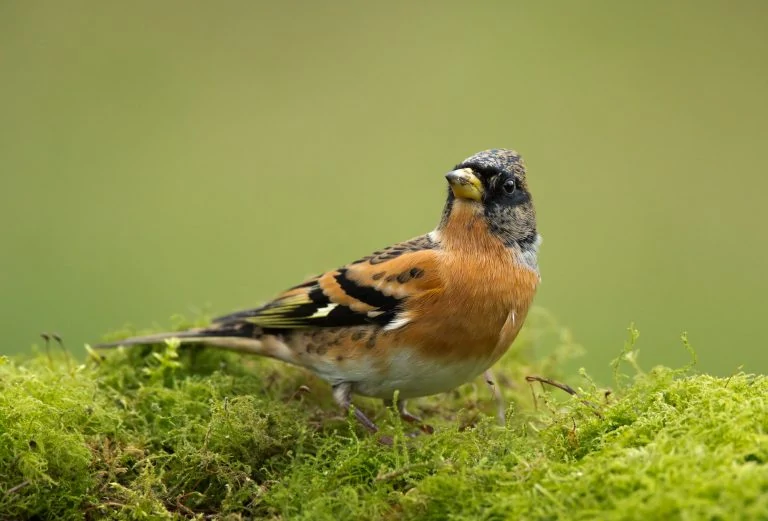
Bramblings are orange and black birds with, orange chests, white bellies, black heads and dark backs. Females are paler than males.
- Length: 16 cm
- Weight: 23-29 g
- Wingspan: 25–26 cm
Bramblings are finches that are usually spotted in Europe and Asia but some appear in Alaska during migration. Those birds that appear in the US may stay in the US but move south during the winter. They may also visit backyard feeders.
Black-headed Grosbeak

Black-headed Grosbeaks are large orange and black songbirds with orange breasts and throats and black wings and heads. Females are brown on the back and with brown spots on their pale orange breasts.
- Length: 7.1-7.5 in (18-19 cm)
- Weight: 1.2-1.7 oz (35-49 g)
- Wingspan: 12.6 in (32 cm)
Black-headed Grosbeaks breed in western US states and migrate to Mexico for the winter. They can be found in many habitats with access to water and often visit backyards.
Attract Black-headed Grosbeaks to your backyard with sunflower seed feeders. They will also feed on oriole feeders.
Northern Red Bishop
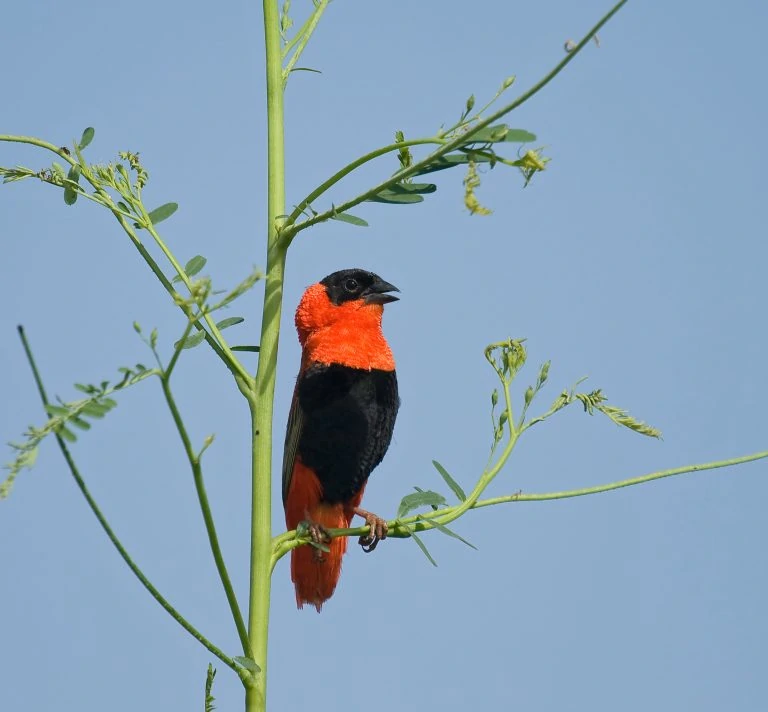
Northern Red Bishops are small weaver birds originally from Africa. Male birds have orange and black coloring in the breeding season, some tend to be more red and black. Females are brown and white, but with a similar pattern.
Northern Red Bishops are about 4 inches long and usually live in the tall grasslands of northern Africa. Populations, though to be from escaped pet birds now live in California and Texas and Florida.
Their diet is seeds and insects and the males build a spherical nest with an entrance on the side.
Western Tanager
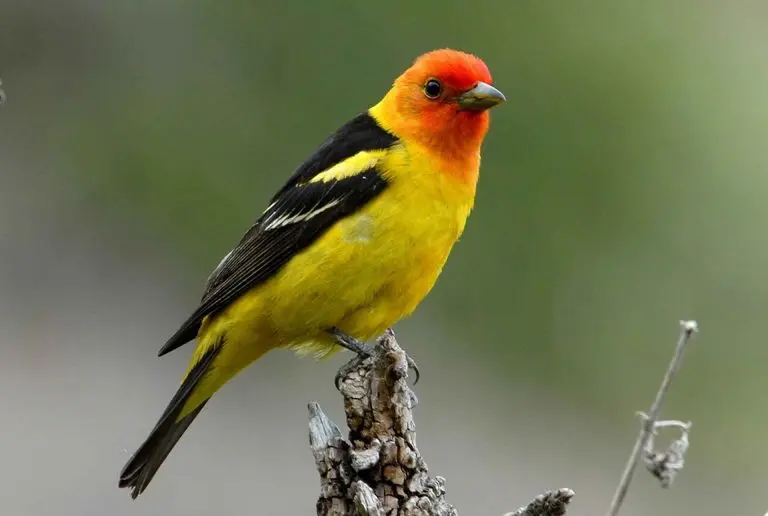
Western Tanagers have a flaming orange-red head, yellow body, and black wings. They can be found all over western states breeding towards the north and then migrating south for winter.
They live in open conifer forests but stay hidden in the canopy, despite their bright coloring. The red coloring probably comes from eating insects that produce a pigment that the Western Tanagers cannot produce themselves.
You can attract Western Tanagers with dried fruit, cut oranges, and other fruits from bird feeders.
Scarlet Tanager
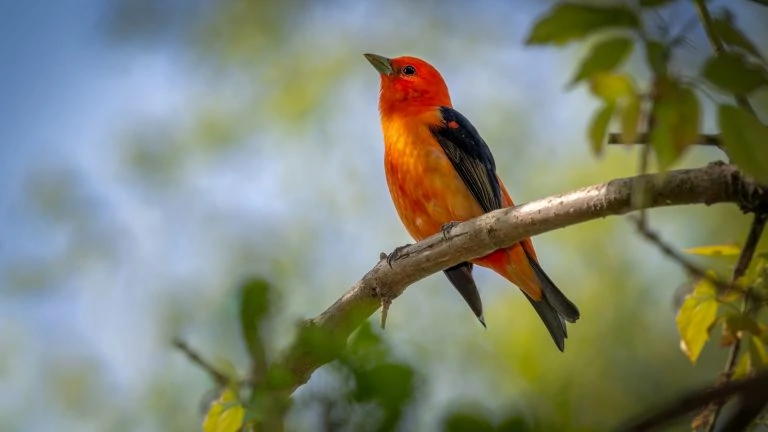
Scarlet Tanagers are birds with orange bodies that turns redder towards the head, and with black wings and tail. They breed in eastern forests in summer before migrating to South America.
Scarlet Tanagers can be hard to spot as they stay high in the forest canopy.
You can attract more Scarlet Tanagers by planting berry plants such as blackberries, raspberries, huckleberries, juneberries, serviceberries, mulberries, strawberries and chokeberries.
Flame-colored Tanager
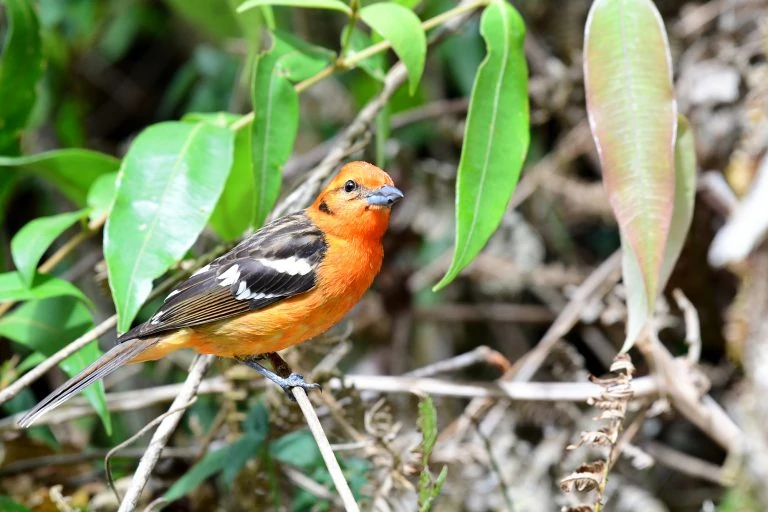
Male Flame-colored Tanagers are brightly colored birds with orange-red coloring, with darker wings and tails. Females are more yellow-orange.
Length: (18 – 19 cm)
Weight 1.13 – 1.71 oz (32 – 48 g).
A rare visitor to the US, the Flame-colored Tanager has started breeding in Arizona and has been spotted in Texas. They usually inhabit woodland Mexico and Central America. Their diet is insects and berries.
Varied Thrush
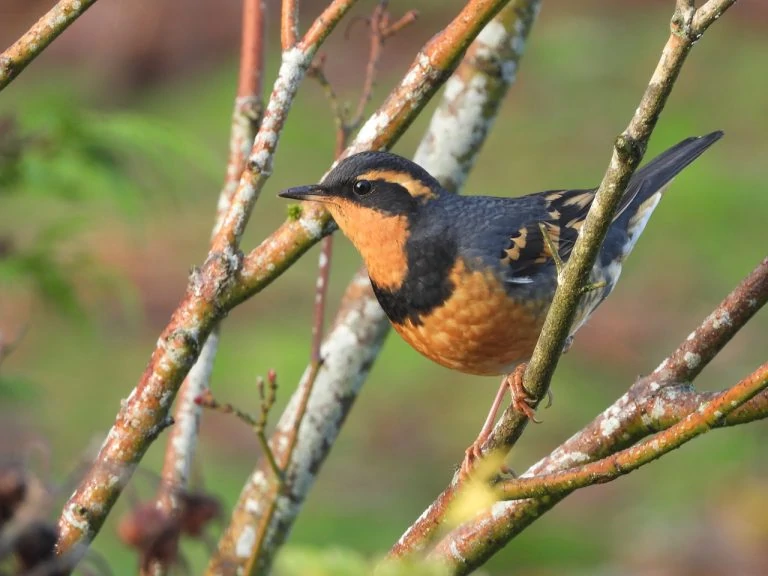
Varied Thrush males are birds with orange breasts and throats and black backs. The males also have orange bars on the wings and orange stripes on the sides of the black heads. Females are paler and have more brown tones on the back.
- Length: 7.5-10.2 in (19-26 cm)
- Weight: 2.3-3.5 oz (65-100 g)
- Wingspan: 13.4-15.0 in (34-38 cm)
Varied Thrush can be found along the Pacific Coast and Breed in Alaska and Northwestern Canada. Some remain all year in British Columbia and Northwestern Us states, along the coast. In winter birds from Alaska and inland Canada move south as far as California.
They are shy birds that hide in the forest looking for insects in the summer and berries and seeds in the winter.
Western Spindalis
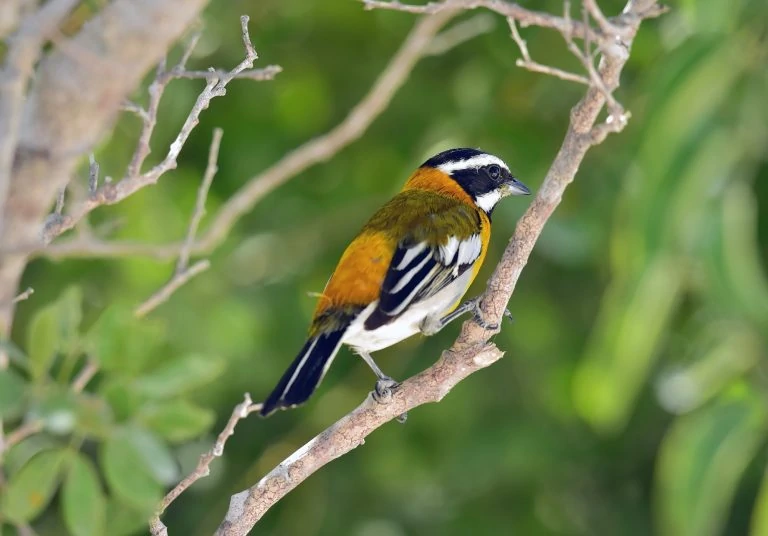
Western Spindalis males have bright orange throats and black-and-white striped heads. Their backs are either green or black with some orange color. Females are less bright but have similar coloring and patterns.
They live predominantly in the Caribbean but they also are found in southern Florida. Western Spindalis Habitat is are subtropical and tropical forests.
Western Spindalis are songbirds that feed on fruit, berries, seeds and insects. They make a small cup-shaped nest made from grass and weeds.

